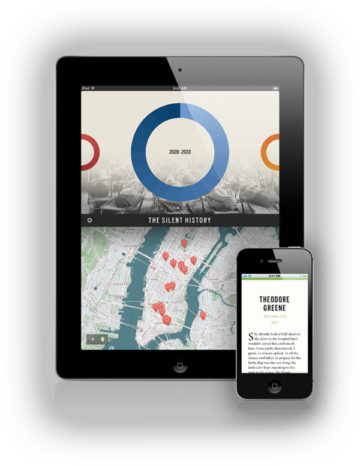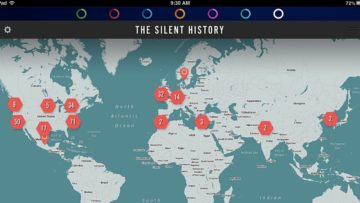When I was in school in the 90s, we learnt history by reading from books. If we were lucky, the books had colored pictures and nice paper, but more often than not, the books were printed on low quality paper and had black and white images. We learned about the leaders of our country as well as the events that shaped the world. I often read the history book like a detailed novel that I had to memorize. Though I will not be teaching history myself, my new friend, Andrew Mills, M.A.T, and his attempt to make social sciences more engaging has me thinking about how we, as teachers, can use technology as well as be inspired by technology.
Here, I want to mention the idea of teaching history as an archival project, inspired by the iOS app, The Silent History. Andy has generously reviewed this article and added to my points around implementing an archival project in his class.
The App

The Silent History is a digital fiction available on the iOS. It is described as a ‘groundbreaking digital novel’ and presents the history of a phenomenon called Emergent Phasic Resistance, spanning over 3 decades. The children affected by this condition do not have any language capabilities and the app presents the story of the effects on culture, social, material and technology due to the existence of these children, referred to as ‘silents’.
The whole narrative revolves around the efforts to help children who are nonverbal, to develop linguistic capabilities as they have no neural capacity for processing linguistic communication. This shows the importance of language in the development of society: without language we would have no written record and no understanding of the past. Since silents could not communicate using language, the only way for the society as a whole to understand them would have been through these records of people who interacted with them.
The app is organized as follows:
- There is an introductory video has pictures, musical soundtrack, etc., to provide a summary of the condition and unfolding of related events
- A scientific video, complete with brain scans, providing scientific standing for the condition, produced by Department of Health and Human Services.
- Testimonials of over 150 characters who come from different walks of life such as teachers, parents, medical specialists, nurses, government officials classmates to silents, who have interacted with the silents. Each testimonial is an oral account, that is, as one reads it, it feels like the person is talking to the reader. There is a place associated with each testimonial as well. Each testimonial unlocks when the previous one has been read.
- There are further testimonials, called field reports, that can be accessed around the world and the app developers welcome users to contribute field reports to the project. These reports tie the reader’s surroundings into the story and become available when he/she is a couple meters from the place to which the report is associated. Thus, the field reports encourage readers to physically explore places where ‘history’ took place. Since it is not possible to travel the world within a term for the sole reason to explore all field reports, this can foster collaboration between readers around the world by sharing their experience at a location.

We archive something that has already happened. Thus, this spectacular works falls under the category of quasi-fiction, or seemingly non-fiction, as it is an archival project of a phenomenon that does not exist in our real world. Multiple supports are given for the phenomenon using multimedia elements, testimonials and field reports (Meurer, 2017).
Inspiration from The Silent History
I thoroughly enjoyed the way history was presented by the app and I feel there are many new ideas can be generated based on this reading experience. Athitakis (2013) elaborates on them in his review:
- Design: The app has three design elements that make reading more engaging over the book.
– It is easy to navigate and user friendly.
– The colors used in the app are soothing to the eye.
– There is a high level of interactivity within the app due to the use of GPS data and the multimedia elements. - The testimonials: They are brief and concise chapters which give the reader the feeling that they are part of the conversation. History books generally state facts and do not express feelings. There is a cause-and-effect of all events, yet it is hard to derive a personal connection with the subject matter.
- Locations: We often visit historical sites in the course of our history studies. Through the medium of field reports which also contain a short testimonial, a story is weaved into the location, to be accessed at that spot.
What we can take to the classroom
Though I do not advocate for building an app to teach history in this format (though if you have the time or need some help, please do and share it with us!), I certainly believe that many of the aforementioned elements can be easily incorporated into the history classroom.
Imagine teaching your students about your city’s history. There might be a field trip to show them some historical sites, and some videos to learn more. In textbooks, the focus might be on people like the mayor and the person who established the city and so on. Now imagine, giving the students to research more, to dig deeper into the aspects of the city that they live in.
- Experiential learning is learning through experience. Visiting historic sites, maybe even taking part in simulation of activities from the past age would help students relate to the past better. The teacher could divide students into groups to visit certain sites over the course of a month and submit an oral account of their trip. They can also present their experiences in their Interactive Student Notebooks (ISN) or blogs or in the form of a poster, for example. A neat trick is to dye the pages of the ISN with tea to get the look of old pages and present their experience on them.
- Students focus on the common people in the past — those who were not mayors or founders, and instead teachers and carpenters and builders and find out what technology they had available to them then, what schools looked like a couple decades ago. Students can put themselves in the shoes of these people and express how life would be for them. Any activity that helps students draw connections between content and their lives will make learning more memorable, and therefore more easily accessible and impactful.
- There are many apps such as Seesaw that allow students and teachers to work on a blog together. This could be a great place to integrate the different artifacts collected by the students, be it videos, audios, posters, written notes in ink, and so on.
- Interactive Student Notebooks and student blogs are great way for student to build artifacts to showcase their learning. By allowing them to focus on aspects of history that they are curious about, students would be pursuing an interest and have free reign on how to present it. This links to differentiated instruction, by product in particular. Perhaps this could turn into a large-scale project, where students investigate and record information as some type of performance assessment (GRASP or RAFT).
By experiencing history outside of the book, putting their thinking caps on and researching the challenges and opportunities that people had in the past, students will be able to enjoy history more and link it to areas they are curious about.
Conclusion
We often think about and are resistant to incorporating technology in the classroom. Through my encounter with The Silent History, I realize that technology plays another important role — that of inspiration. There are a plethora of great projects happening in the field of cyberliterature and I am confidant we can learn a lot from the artists working on these projects. A few notable ones are: Bad Influences, a blog set in a post-apocalyptic time when only a couple of people and the Internet survived, and digital comics such as The Boat, which depicts the experience of migration from Vietnam to other countries in time of war. More on these incredible works later. 🙂
References:
Athitakis, M. (2013) A Review of The Silent History. Retrieved from http://www.vqronline.org/books/review-silent-history
Meurer, D. (2017). Conditions of presence: Topological complementarities in The Silent History. Paradox (29).

Be First to Comment